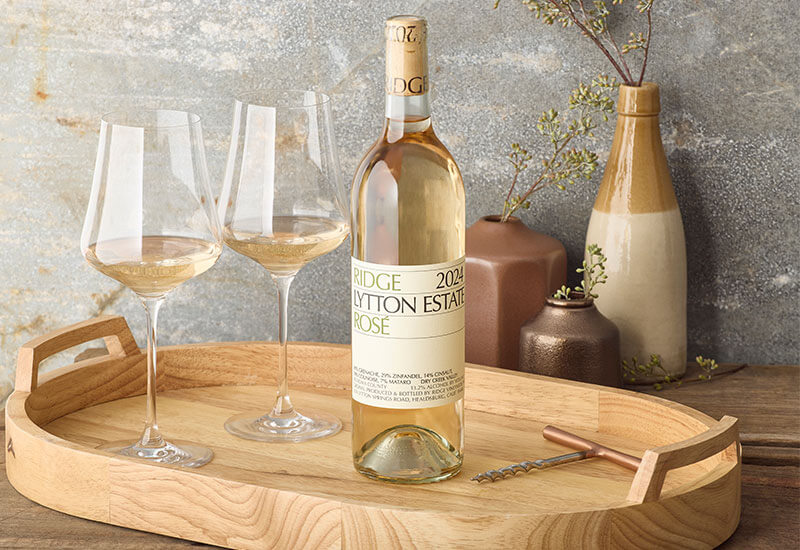How is Rosé Made?
Blog Post
Assistant Winemaker Michael Bairdsmith talks about the history of rosé in California, popular methods for producing rosé, and how we make our Lytton Estate Rosé here at RIDGE.
Around the world, rosé is a staple in most major winegrowing regions. While not new to California, its recognition as a versatile, dynamic, and food-friendly wine was slower to evolve here in the Golden State than in other parts of the world. These days, however, more and more California producers are giving rosé its long overdue moment in the sun.
Different Styles of Rosé: Saignée vs Direct-to-Press
The styles of rosé produced in California run the gamut. Many winemakers utilize classic European techniques, which rely on a wide variety of grapes, a broad spectrum of vinification practices, and even special farming considerations that can affect the final rosé. Generally speaking, however, there are two main methods used when making rosé: saignée and direct-to-press.
1. Saignée
The saignée method came about as a byproduct of traditional red wine production. Grapes harvested to produce red wine are removed from their stems and crushed. The crushed fruit, pulp, skin, and seeds are left in a vessel to “macerate”as they ferment, during which the skins and other solids from the grape impart color, flavor, and tannin. A trick vintners discovered long ago was that one could increase the concentration and structure of their red wines by draining some of the juice out of their fermentation vessel not long after crushing their grapes. Doing so increases the skin to juice ratio, creating a more robust red, and has the added benefit of leaving the vintner with some pale pink juice that could be fermented off the skins. Saignée literally means “to bleed” the juice off the skins; a technique which produces a rosé often on the darker end of the spectrum, with rich aromatics and body, but often lacking natural acidity. For stylistic reasons, the saignée method is not the method we use when making Ridge rosé.
2. Direct-to-Press – Our Preferred Method
Here at Ridge, we made our first rosé available to the public with our 2015 Lytton Estate Rosé, using the direct-to-press method. The saignée method described above utilizes grapes picked at a level of ripeness appropriate for red wine. We prefer a more Provençal style of rosé with bright natural acidity, delicate flavors, and a pale pink hue. In order to achieve this, we pick the grapes for our rosé much sooner than we would pick for a red wine. We also forego the crushing process, preferring to gently press the grapes, whole-cluster, to extract pale “vin gris” style juice. This juice is then fermented at low temperatures in stainless steel, where it remains to settle out before it is bottled with no oak barrel aging.
Which Grape Varieties are used to Make Rosé?
We pick and press grape varieties like grenache, mataro (mourvèdre), zinfandel, and other estate-grown grapes, and ferment the wines in small batches. We then blind taste through the separate lots and determine which will go into the final blend, just as we would with our Monte Bello, Lytton Springs and Geyserville. Once the assemblage is complete, we bottle the wine in time for a spring release. Subtle fruit and crisp acidity pairs beautifully with salad niçoise, seafood risotto, pasta primavera, and a host of Asian-influenced dishes.
Related Articles:
- What is a Wine Grape Clone?
- Wine Ingredient Labeling & Transparency
- Pre-Industrial Winemaking at RIDGE
- How to Double-Decant a Wine

Stay up-to-date with the latest RIDGE news, wine releases, and special offers – join our mailing list.
Wait!
In order to qualify for user related discounts, you must log in before proceeding with checkout. Click the button below to log in and receive these benefits, or close the window to continue.
Log In